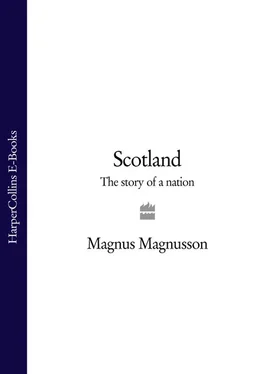In a sense the Antonine Wall was as much a customs barrier as a defensive wall; it was a means of controlling trade and traffic moving into and out of the Roman province, as well as a base for military patrols into the native territory to the north. One of those frontier posts was Bearsden.
The fort at Bearsden has long since been engulfed by the tide of neat housing of this douce suburb on the north of Glasgow; the houses now sitting on the site overlook the Bath-House which lay in a large annexe attached to the wall. The legionaries coming off sentry duty were able to choose between a plunge in the Cold Room and Bath ( Frigidarium ), or the Hot Dry Room ( Sudatorium ) with its graded Warm Rooms (Tepidaria) . To one side lay a stone-built communal latrine housing a wooden bench with round holes cut in it for seating over the sewer channel.
The Bearsden Bath-House with its ‘mod cons’ presents a vivid picture of the advance of Roman civilisation into the wildlands of Scotland. It brings us from prehistory into history ‘proper’. But it also foreshadows the long struggle to settle a border between north and south, between Scotland and England.
Iain MacIvor, former Chief Inspector of Ancient Monuments for Historic Scotland, says:
The first military works to divide north from south Britain were made by the Romans, and for a long time there was a fanciful link between the famous wall from the Tyne to the Solway [Hadrian’s Wall] and the border between Scotland and England. The Scots were to find a lasting source of national pride in the notion that, whereas the southern parts of Britannia had been taken over without too much difficulty by the mighty Roman army, their own ancestors had held out against the Roman Empire for centuries, and that this undaunted resistance forced the Romans to build one of the wonders of Europe to protect their province of Britannia – Hadrian’s Wall.
The location of the Roman frontier in the north varied considerably over the years. Julius Caesar claimed a ‘Conquest’ after his two invasions in 55 and 54 BC; but it was not until the massive invasion of AD 43 under the Emperor Claudius that the real conquest of southern Britain began. It took the Romans a full forty years of gradual advance and consolidation to become masters of their new province of Britannia. In the course of these four decades they suffered some severe setbacks, including the ferocious uprising of the Iceni tribe of Norfolk and Suffolk under their redoubtable warrior queen Boudica in AD 60–1. By AD 79, however, all England and Wales had been subdued. Now only the far north remained: the Lowlands and Highlands of Scotland. These were terrae incognitae to the Romans: unreconnoitred badlands inhabited by (to them) unknown but ferociously barbarian tribes.
There seem to have been three tribes in the Lowlands at this time: the Votadini in the east with their capital Traprain Law in Lothian; the Novantae in the south-west (Dumfries and Galloway); and in between them the Selgovae, whose territory reached from Eskdale to the Cheviot Hills.
The hill-fort of the Votadini on Traprain Law (152 metres) had earthen ramparts (now almost invisible) enclosing sixteen hectares. It was more than just a stronghold or a refuge: it housed a permanent settlement and the administration of the district – an embryo town or burgh, in effect. The Votadini would later shift their capital from Traprain Law to Edinburgh (Din Eidyn), probably to the Castle Rock, and would be known in heroic legend as the Gododdin ( see Chapter 3).
Around the Firth of Clyde were the Damnonii. Above that were the mountainous lands of many Highland tribes, collectively called the Caledonii (Caledonians) by Tacitus.
In AD 78 the newly-appointed Governor of the Province of Britannia, Julius Agricola, embarked on a vigorous policy of subduing the native tribes still beyond Roman control in Wales and the north of England. Then he turned his mind to an invasion of Scotland. With him was his son-in-law, the historian Tacitus, who would write (in AD 98) an account of the campaigns in Scotland in his Life of Agricola. In AD 80 Agricola launched his blitzkrieg with a pincer movement. He sent his Ninth Legion up through the territory of the Votadini on the east side of Scotland, following the line of today’s A68 through Lauderdale and north over the Lammermuirs at Soutra to Lothian and the Firth of Forth. Meanwhile the Twentieth Legion moved up the west side through Annandale, along the line of today’s M74 to Clydesdale and the Firth of Clyde. Then the two legions joined forces and marched up to the Firth of Tay. By AD 82 Agricola had subdued the Novantae in the south-west and secured the occupation of Scotland below the Central Belt. He made treaties and alliances with the native peoples where he could, and consolidated his grip by building several garrison forts, the most substantial of which was at Newstead, next to the Eildon peaks near Melrose. He also built a string of small forts (without a continuous barrier) which superintended a line between the Clyde and Forth, with a network of roads to secure the territory to the south.
What was the impact of the Roman incursion into the Lowlands of Scotland? Anna Ritchie, freelance archaeologist and prolific writer on the archaeology and history of early Scotland, says:
At the time the impact must really have been remarkable, because the tribesmen would never have seen anything like the Roman military machine which marched into Scotland.
And there was also an immense economic effect. Once the Roman army was established in the Lowlands of Scotland, there was an impact on agriculture because the army had to be fed. They needed immense quantities of grain, and that grain had to be obtained locally once the supplies they brought with them were finished. You can see that archaeologically, in fact, in these great souterrains, or earth houses: underground storage chambers, some of which are so large that they cannot just have been for the needs of the little settlements in which they lie; they can only be that size because they were storing the grain for the occupying army.
Another area of impact would have been the transport network they needed for military mobility, for provisioning the army and for sending messages between battalions. That must have been quite stunning in the eyes of the local peoples, because there had been nothing more than tracks until that time. The roads and the great forts with their ramparts and huge wooden gateways would have been a glimpse of a totally alien world.
Agricola’s ambitions did not stop at the Clyde – Forth isthmus. His ultimate aim was the conquest of the whole of northern Britain. In AD 83 he started his march north, with a powerful fleet in support. He had a formidable army under his command: three full legions of crack Roman infantrymen supported by cavalry and squadrons of battle-hardened auxiliaries. He wintered on the Tay, and next spring continued his advance northwards up the coastal plain, taking out any native settlements on the way and building a series of temporary marching camps. Meanwhile the Caledonians, according to Tacitus, ‘turned to armed resistance on a large scale’.
Agricola’s strategy was to bring the Caledonians, under their leader Calgacus, to pitched battle. In the late summer of AD 84 the strategy succeeded. The locations of Agricola’s marching camps suggest that he cut across country from Stonehaven into Morayshire along the line of the modern A96 to Inverurie and Huntly; and there, somewhere in the north-east, at a place which Tacitus called Mons Graupius (the ‘Graupian Mountain’), the two sides met for the final battle.
More than thirty thousand of the Caledonian tribesmen had gathered in close-packed tiers on the slope of a hill. In the valley between the two armies the Caledonian charioteers careered back and forth, taunting the Romans and displaying their skills, daring them to advance. And advance they did; under the personal command of Agricola, the auxiliary squadrons moved forward in a disciplined frontal attack while the cavalry engaged the charioteers. The Caledonians fought with reckless courage, but gradually they were outflanked and outfought at close quarters. By the end of the day they had been comprehensively routed amid fearful slaughter: ten thousand tribesmen were said by Tacitus to have perished, at a cost of only 360 Roman dead. The survivors scattered and fled ‘far into the trackless wilds’.
Читать дальше












